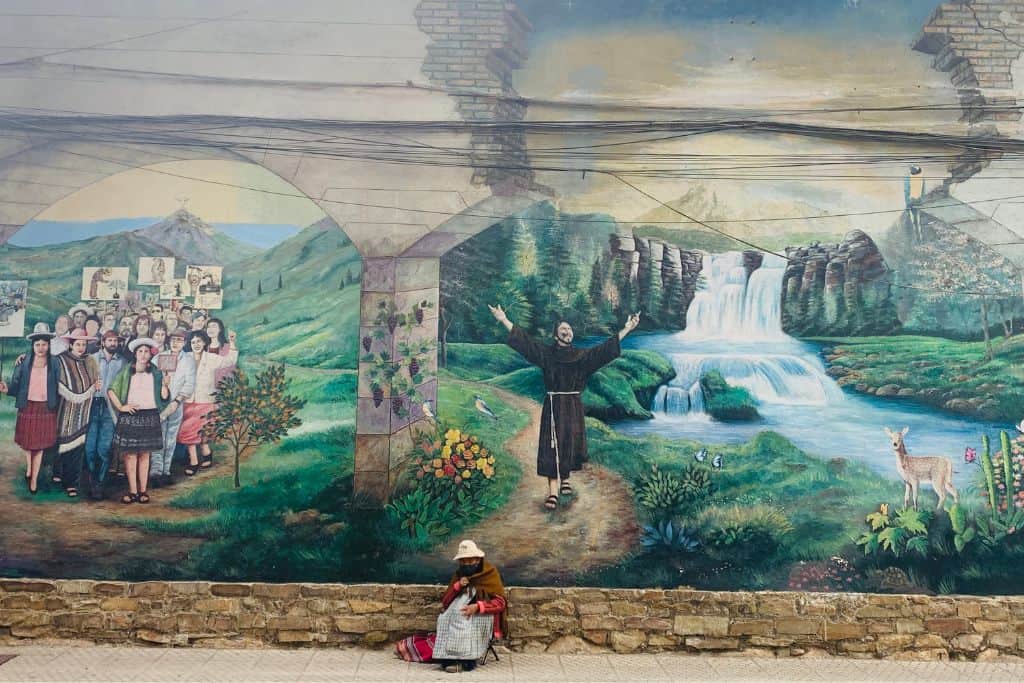Why You SHOULD NOT Skip Bolivia: Our 3-Month Travel Guide To Bolivia
Is Bolivia Worth Traveling?
Of course it is! Bolivia stole our hearts and that is why you should not skip Bolivia. This country has so much to offer if you know how to plan right. But let’s be real: Bolivia does get a bad rep in the travel world.
“Don’t drink the water.”
“You’ll get food poisoning.”
“The infrastructure isn’t great.”
You’ve probably heard some version of this if you’re planning a trip.
But here’s the thing – we spent three whole months traveling slowly through Bolivia, living in local neighborhoods, hopping between cities, trying all the food (yes, street food included)… and we didn’t get sick. Not even once. If you’re the kind of traveler who wants to experience authentic, raw, beautiful landscapes without emptying your bank account – Bolivia is one of the best places you can go. And I’m here to help you do it right.
Plan Your Trip With My Favorite Resources
-> Best accommodation site: Booking.com
–> Book the tours here: Getyourguide.com
–> Best car rentals: Discovercars.com
–> Get an eSIM to make sure you always have data: Airalo.com
Money Exchange in Bolivia: Bring the Dollars
Important things first. In order to travel, you need money.
One of the best pieces of advice we got before arriving in Bolivia was:
“Bring USD in cash. And lots of it.”
Due to Bolivia’s ongoing economic crisis, US dollars are in short supply, and exchange rates vary dramatically depending on where you convert your money.
- Bank rate: 1 USD = 6.9 BOB
- Street rate (Casa de Cambio): As high as 1 USD = 17 BOB (June 2025)
That’s not a typo. Changing money at a reputable street cambio can more than double your local spending power. These cambios are especially common in busy parts of the major cities like La Paz and Sucre.
To Note:
- Bring new, crisp US bills – torn or worn bills often get rejected.
- Ask around for the best rate – they change daily and vary a lot.
- Negotiate politely – you might get a slightly better deal for exchanging larger amounts.
- Don’t rely on ATMs for USD – most only dispense BOB and might charge fees or have limits.
Card payments
Some restaurants and supermarkets accept Visa or Mastercard, but using foreign cards often triggers a “foreign transaction fee” or inflated conversion rates. The places that accept card can also charge an extra fee and all these add up! Plus, you could get double the value of your money if you pay in cash so why to use a credit card.
Food & Water in Bolivia: Surprising Wins
Before arriving, we’d read horror stories of food poisoning and stomach bugs. But in our three months of slow travel across Bolivia – eating from mercados and food stalls, we were totally fine. No tummy troubles here.
Best Food in Bolivia: Cochabamba
Known as Bolivia’s gastronomical capital, Cochabamba absolutely blew us away with its food. Local people are proud of their cuisine, and rightly so – it’s flavorful, spicy (spice served on the side mostly), and generously portioned.
Must-try dishes in Cochabamba:
- Pique Macho: Huge plate of beef strips, sausages, fries, veggies, boiled egg – a local favorite for sharing.
- Silpancho: Breaded meat served with rice, potatoes, fried egg, and salad.
- Sopa de Maní: Creamy peanut soup, with pasta and potato – surprisingly filling!
- Anticuchos: Grilled beef heart skewers with potatoes and spicy peanut sauce, usually sold at night.
- Lapping: Grilled, marinated beef, served with potatoes, veggies, and corn.
- Hamburguesas Cochabambinas: Flavorful street burgers costing between 10-15 BOB.
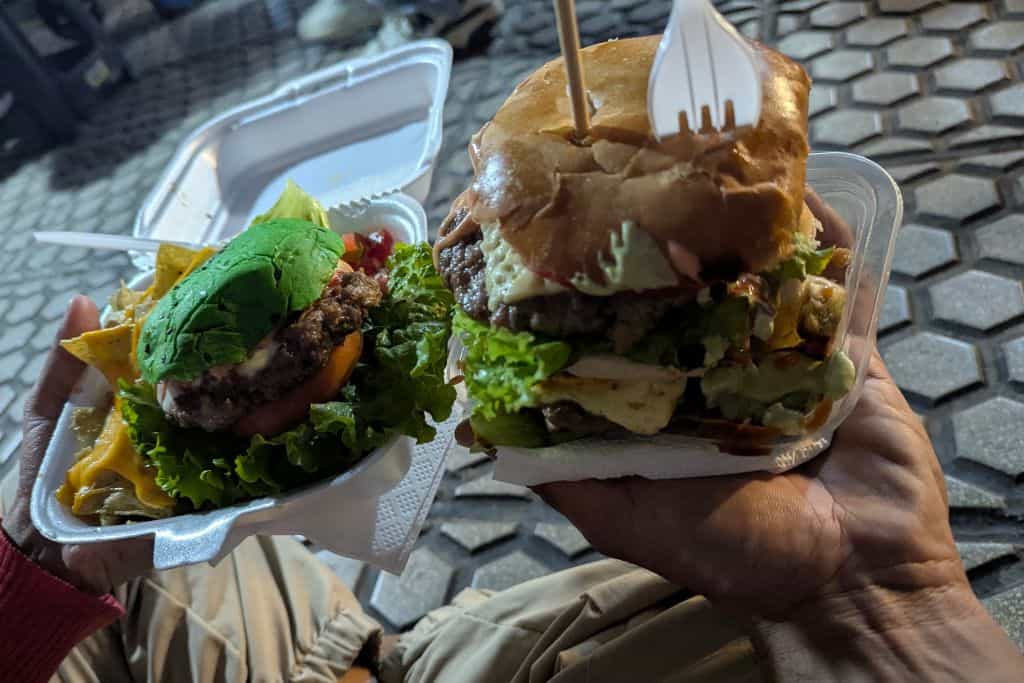
In Sucre, food leaned slightly lighter and cheaper – the typical Sucre dish is “Mondongo” – a meat curry. Our favourite place was Mercado Central for cheap food, fresh juices, and pretty much everything you need. Apart from it, the fresh fruit juices were made with filtered water and costed less than a dollar!
In Sucre, don’t miss the restaurant La Nativa to have a fine dining experience for less than 200 BOB!
In La Paz, out of many options, our favorite snack was Choripan in the Mercado Lanza by Doña Elvira.
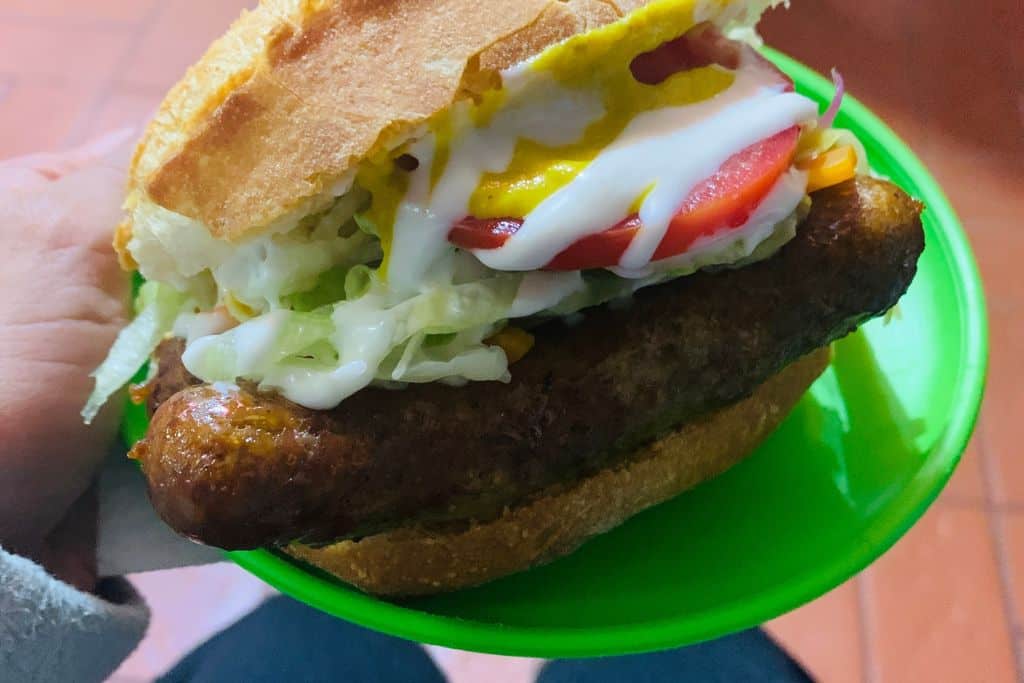
Talking about drinks, do NOT forget to try Api Morada! This is a traditional Bolivian drink made with purple corn, with a hint of lemon and cinnamon. Its thick, hot, and absolutely addictive! Some places with mix the purple api and yellow corn drink but ask for “Api Puro” which means only the purple corn drink!
Water Tips
Probably you know this – but incase if you don’t: “Do not drink tap water in Bolivia”
Rule of thumb is not to drink tap water, not to eat fresh salads from restaurants, not to eat sushi (as it has raw ingredients and has made some people sick). Be careful, take it slow but also don’t be too scared and end up not eating or drinking anything. Because you should NOT miss the amazing and flavourful Bolivian food!
For drinking water – at first, we bought bottled water, but we quickly switched to “bolsitas de agua”, the little sealed 500ml pouches sold everywhere for 1 BOB. We used them to refill our reusable bottles.
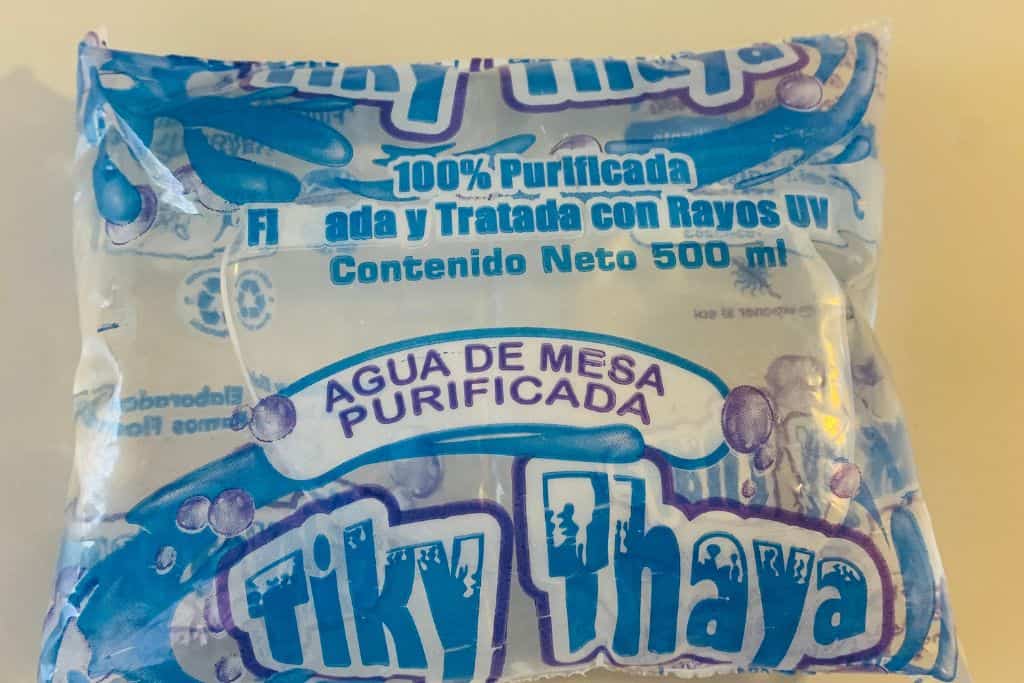
You’ll see locals drinking them all the time – it’s totally normal and very cost-effective.
Inter-City Buses & Local Transport
Long Distance Buses
We took multiple long-distance buses in Bolivia – from Uyuni to Sucre, Sucre to Cochabamba, Cochabamba to La Paz, to Rurrenabaque, and to Copacabana.
- We always booked “Cama” seats – 160 degree reclining seats with leg rests.
- Most buses leave at night, which saves on accommodation and gives you a full travel day.
- Expect noisy rides – people watch movies on loudspeakers or talk on the phone without headphones.
- Bring snacks, water, and toilet paper (trust us).
- Some buses advertise bathrooms, but they may be locked so don’t rely on them.
For us, we never faced any crazy driving, except once where we arrived 2 hrs earlier than scheduled! We also took the 15 hr bus from La Paz to Rurrenabaque (on the death road) and it was super smooth! Our recommended operators are 6 de Octubre, Trans Copacabana, and Flota Yungueña for going to Rurrenabaque as they are known for safe driving.
Urban Transport: La Paz Cable Cars (Mi Teleférico)
If you are travelling to La Paz, the best way to explore and understand the city is through the teleféricos (cable cars!).
- Each ride = 3 BOB.
- Fast, safe, clean, and insanely scenic.
- Multiple lines (color-coded), connecting the valleys of La Paz to the hills of El Alto.
- You can switch lines mid-ride, just like a subway, but have to pay 2 BOB for the line exchange.
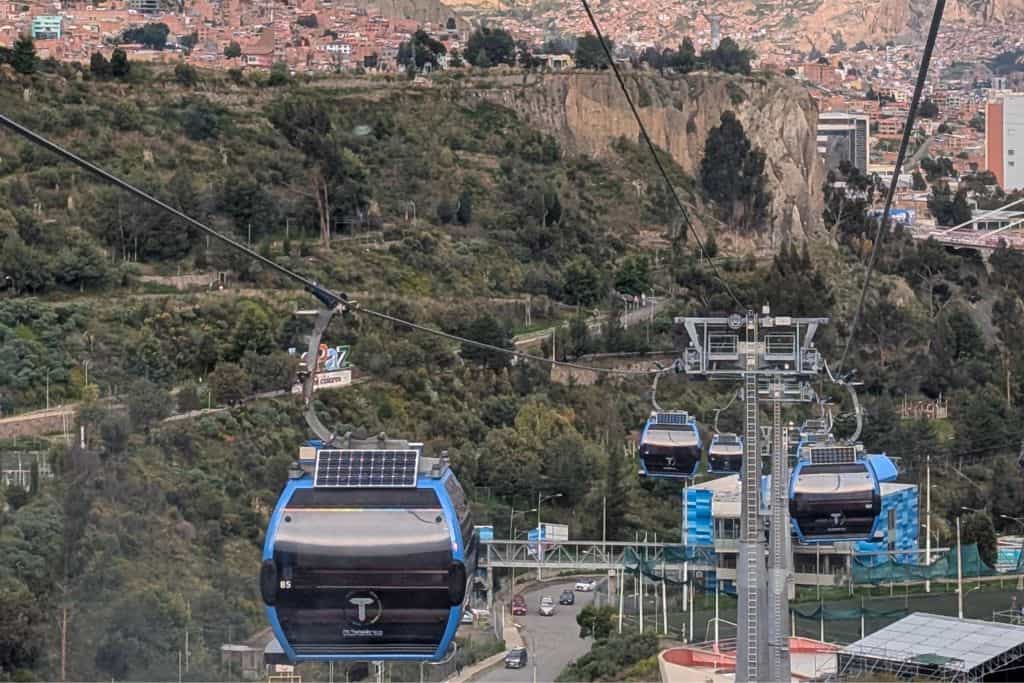
We were amazed at how clean the cable cars and the stations were!
Local Vans (Trufis) and Micros
In Cochabamba and Sucre, we took trufis a few times – minivans that follow semi-fixed routes. You pay the driver when you get on or off, and shout “¡Baja!” to get off.
They’re super local, cheap, and surprisingly efficient. But no signage and no set bus stops, so best to ask someone before you board.
Hot Showers in Bolivia: A Real Hit-or-Miss
You learn quickly in Bolivia that a hot shower is a luxury – not a guarantee.
Most showers use a small electric water heater mounted on the showerhead. You’ll see wires taped around the wall (yes, really). It’s common and not dangerous.
The Trick:
If you open the tap all the way, the heater can’t keep up. Open the water flow just enough to get the hottest possible water. Places we stayed in Sucre and Uyuni had just-lukewarm showers, which was brutal in the cold. But in La Paz, we finally got a reliably hot shower – and it was amazing!
Natural Beauty
Bolivia’s natural landscapes are otherworldly – but trails are often unmarked, and cell signal is unreliable, so tours are the best way to go.
They’re also super budget-friendly and often include:
- Roundtrip transport
- Meals
- Guide (Spanish-speaking, sometimes bilingual)
Tours we loved
- Amazon Jungle Tour (Rurrenabaque) – We went with Indigena Tours.
Saw caimans, pink dolphins, howler monkeys, and so many birds. Slept in a jungle lodge, all meals included, hammocks for downtime. - Maragua Crater Hike (from Sucre) – Booked with Greentrekkers, we did 2 days of hiking through ancient crater landscapes and dinosaur tracks. We stayed the night in the crater and had amazing meals. Our guide Renee was amazing!
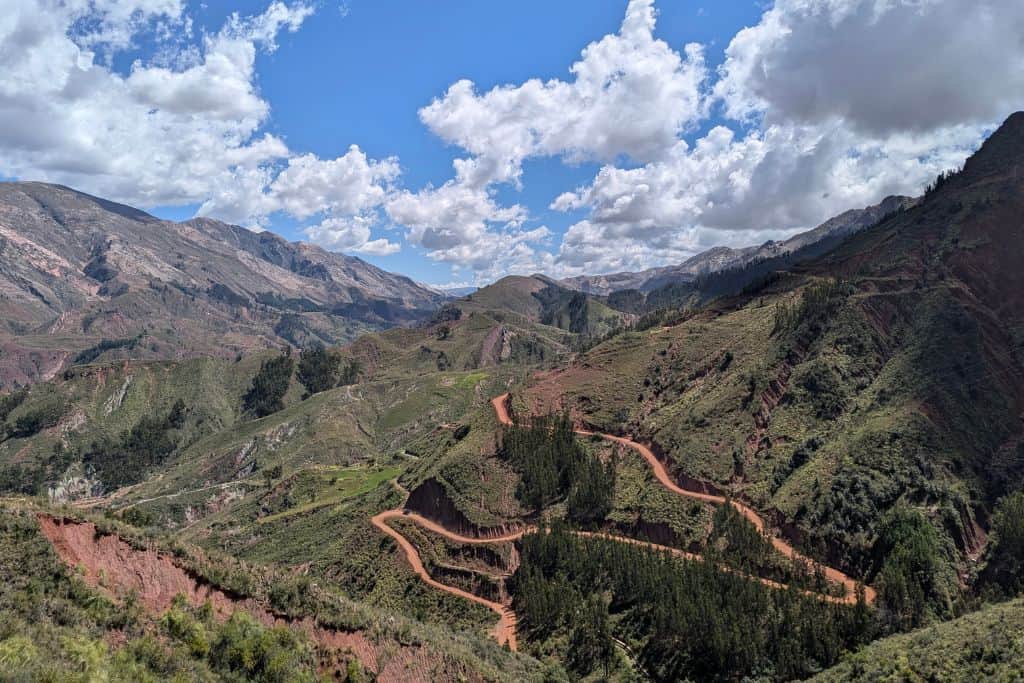
- Pico Austria Hike (La Paz) – First ever 5000 m hike! It was beautiful and definitely worth doing. It acts as a preparatory hike for Huyana Potosi which goes up to 6000 m. Even if you don’t plan to do Huyana Potosi, this will act as a challenging hike which is super beautiful.
- Huyana Potosi (La Paz) – A 6000 m climb to summit the beautiful Huyana Potosi. One of the most challenging and most rewarding treks!
Booking is easy – we just walked around and compared prices in person before booking with an agency.
Shopping & Souvenirs
You’ll be tempted by alpaca-blend everything, from scarves and socks to sweaters and throws. But make sure you know how to differenciate between a true vs a fake alpaca material.
And yes, everyone ends up buying a fake Patagonia fleece – it’s practically a rite of passage for backpackers. For only 135 BOB, you can get a customized fleece jacket stitched by a tailor. It takes 4-5 days though so best if you are in the town for a week.

- Best prices: Uyuni – markets near the central plaza or near the salt flat tour operators.
- La Paz: Calle Sagárnaga has everything – but prices are higher. Still, the selection is unbeatable.
Final Thoughts On Why Not To Skip Bolivia
Bolivia was challenging, chaotic, and surprisingly beautiful.
Bolivia isn’t the easiest country to travel – and maybe that’s exactly why it’s so unforgettable.
It’s a place that doesn’t pretend for tourists. The pace is slower, the systems are unpredictable, and things don’t always work the way you expect. But if you allow yourself to surrender a little – to loosen your grip on control – Bolivia reveals a quiet depth that many places never do.
From the big markets of La Paz to the stillness of the Amazon, the kindness of strangers in small towns, the challenge of communicating in places where no one speaks English, the hot showers that make you oddly grateful, and flavourful yet simple cuisine – this country taught us how to live with less, notice more, and lean into simplicity.
It reminded us that not everything beautiful is convenient. And not everything affordable is lacking in value.
We left with a deep respect for Bolivia – for its people, its stories, its resilience.
And honestly, the more time we spent there, the more it felt like a place that doesn’t need to shout to be seen. It just is. And that’s powerful.
So no – Bolivia won’t hand you perfection. But if you stay long enough, slow enough, and open enough, it just might hand you something better.
This post includes affiliate links, which means that if you make a purchase or booking through them, we may receive a small commission. It doesn’t cost you anything extra, but it helps us keep the blog going. We only recommend products or services that we fully trust.
READY TO TRAVEL LIKE A LOCAL?
Book a free 30-minute consulting call with us and let’s start planning your next unforgettable adventure!

